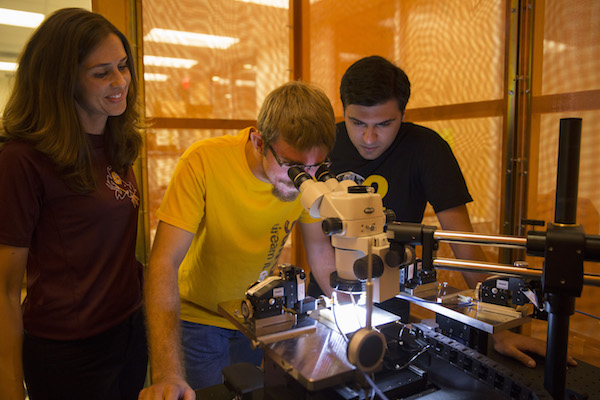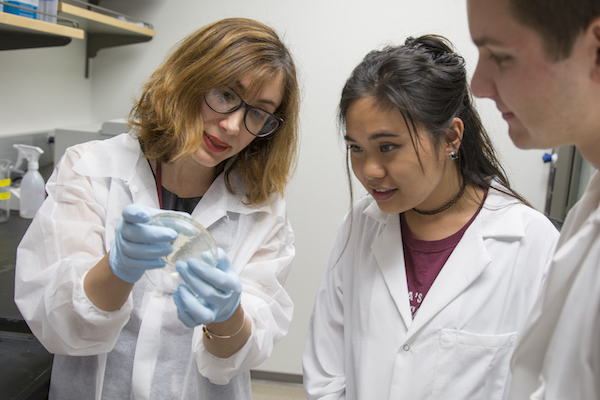
Looking for bigger roles in game-changing leaps in tech capabilities

Above: ASU assistant professor Jennifer Kitchen is pictured in her lab, inside a special copper-screen enclosure designed to keep out wireless electronic signals. The facility will be used to test the performance of transceiver systems as part of Kitchen’s research to improve U.S. military radio communications hardware. The enclosure ensures there won’t be interference from outside wireless signals during testing. Members of her research team include electrical engineering doctoral students Kevin Grout (center) and Soroush Moallemi. Photographer: Peter Zrioka/ASU
DARPA is a beacon for engineers and scientists yearning to take a bit of a walk on the wild side in their research pursuits.
The Defense Advanced Research Projects Agency “is known for being willing to fund some of the most intriguing ‘out-there’ kind of stuff,” says Jamie Winterton. “They like going after the big-picture, game-changing advances in technology, the moonshot research that tries to take big leaps instead of small steps.”
This agency of the U.S. Department of Defense is responsible for promoting the development of emerging technologies for use by the nation’s military forces and other national security operations.
DARPA describes its mission as being an enabler of endeavors to “expand the frontiers of technology and science” for the purpose of ensuring the country’s defense tools remain the most sophisticated, effective and resilient.
From Arizona State University’s perspective, DARPA is “exactly the kind of institution that a university of our size and range of research expertise should be working with more than we are,” says Winterton, the director of strategy for ASU’s Global Security Initiative and leader of its recently created DARPA Working Group.
Learning to do business with defense agencies
In hopes of achieving a more robust working relationship with DARPA, Winterton is trying to foster a closer alignment of the research goals of the university’s engineers and scientists — as well as faculty in some other fields — with the priorities of the defense agency’s decision makers.
Over the past nine months, she has started the ball rolling on programs to educate ASU researchers about how to best connect with DARPA and craft proposals for its research support.
Winterton has been organizing events for faculty members to meet and talk to people who have had experience working with the Department of Defense.
“We’re giving faculty an opportunity to sit down with people who have worked with or for DARPA or who have some broader insight on how national defense agencies do business and what their leadership is interested in,” says Winterton, who has degrees in physics and worked on defense-related research over more than a decade as a scientist in private industry.
Radical but still practical
DARPA projects are attractive to university researchers because they often involve collaborations with industry and other universities and institutions — partnerships that have the potential to boost researchers’ career opportunities.
Those projects can also give researchers the freedom to gamble on exploring ideas that break with conventional thinking.
“DARPA says, ‘We are revolutionary not evolutionary.’ They are not averse to trying something radically different,” Winterton says. “They are not afraid of failure. That’s what makes it fun.”
All that said, DARPA still remains steeped in practicality when it comes to deciding what adventures in research it will fund.
Even when research projects come up short of ambitious goals, some new knowledge the research reveals often has applications to other tech-advancement efforts.
Grant proposals have to make a strong case that something of utilitarian value is going to emerge.
“The defense department wants to know what you’re going to do to solve their problems,” Winterton says. “They want to end up with something that they can take out of the lab and into the world and use.”
‘Editing’ genes to restore hearing loss
Both of those practical and outside-the-box approaches characterize the work to be supported by two new grants that the DARPA Working Group has aided ASU faculty members in attaining.
Samira Kiani will employ her expertise in synthetic biology and gene therapy in trying to develop a safer, more controllable and effective way to restore hearing loss caused by traumatic injury.
Hearing loss due to the booming noises of explosions in combat zones has become a major health threat to troops, and the costs of treatment for the injured is a major economic drain on the U.S. Department of Veterans Affairs, explains Kiani, an assistant professor in the biomedical engineering program in ASU’s Ira A. Fulton Schools of Engineering.
She plans to experiment with the new gene-editing tool known as CRISPR — Clustered regularly interspaced short palindromic repeats, pronounced crisper — to test her ideas for using the technology to manipulate genes in the inner ear.
“By controlling gene expression, specifically by increasing or decreasing the gene expressions that produce certain proteins, we hope to enhance the regeneration of certain cell pods within the ear that get damaged by trauma caused by explosions or other very loud noises,” she says.

Assistant Professor Samira Kiani (left) will use support from her DARPA grant to integrate advanced technologies and treatment methods in efforts to improve treatment for hearing loss. She is pictured in her lab with ASU biomedical engineering student Suyen Go and biochemistry student Warner Kostes. Photographer: Jessica Hochreiter/ASU
Therapy would be more readily available
The work will involve creating new custom-made designs for controlling CRISPR functions to manipulate gene expression in inner ear.
The challenge is to overcome traumatic damage by CRISPR-based gene expression modulation while at the same time spatiotemporally limiting the function of CRISPR for safe human applications.
“We want to see if we can safely stimulate genes to make the proteins that could actually restore nonfunctioning cells in the ear,” she says. “If the system works, it could make treatment and therapy available to people much faster.”
Beyond that, Kiani is hopeful the research will reveal ways such potentially restorative gene therapy could be applied to other organs in the body.
Her DARPA grant of $500,000 over two years, with the potential for another $500,000 for a third year, will enable her to support a graduate student and a postdoctoral research assistant to work with her on the project.
More effective and convenient military communications
Jennifer Kitchen’s work focuses optimizing the efficiency and performance of wireless communications hardware from system architecture to single devices.
Her idea for a proposal for DARPA support was sparked by talks with soldiers in the U.S. Army’s Special Forces — including one of her cousins.
They described their field communications radios as “necessary, but complex and power hungry,” says Kitchen, an assistant professor of electrical engineering in the Fulton Schools.
Military radios operate at lower frequencies than radios for the general public. Lower frequencies have the advantage of operating over longer distances within the designated military spectral bands.
The downsides are that the equipment is bulky, requires large antennas, and eats up a lot of battery power quickly.
“An Army radio is a big box with a processor that has to be plugged into an amplifier, and then you have to plug an antenna into that radio system. You have to assemble it every time, and potentially reconfigure the setup depending upon the wireless method of communication, for example satellite or line-of-sight communications,” Kitchen says. “They also use higher performance, environmentally robust electronics that are harder to design” than those used in consumer electronics.
Research will benefit other efforts to advance electronics
She’s confident that by integrating some of the recent innovations in electronics architecture and processes that she can help make significant strides in “bringing military radios down in size and up in efficiency and resiliency” without losing the benefits of low-frequency systems.
“The goal is to come with a comparatively small wireless electronic device that is not as power hungry, is adaptable to using variable frequencies, won’t jam up communications and could process large data or voice messages,” she says.
The system would enable transmissions to be even more secure, and maybe even capable of stealth communications.
“The dream is to do all of that with something the size of a cell phone,” Kitchen says.
She says the project is certain to contribute useful knowledge for efforts to advance everyday electronic communications, particularly in ramping up efficiency and extending battery life.
Possibility of long-term relationship
DARPA will provide Kitchen about $500,000 over two years, with a potential option for a third-year investment of a comparable amount.
The grant will allow her to put two full-time graduate students on the project team.
“This is particularly good research for students to learn from,” she says.
Like Kiani’s project, Kitchen’s work is being funded through a DARPA Young Faculty Award. These highly sought after awards indicate the agency considers the recipients to be up-and-coming leaders in their fields of expertise whose work promises to provide valuable contributions in the future.
“That’s the attraction of getting a DARPA grant,” Kitchen says. “If you’re successful, the trend is for DARPA to continue to partner with you. They tend to come back to us for new things they need throughout our careers.”
Media Contact
Joe Kullman, [email protected]
480-965-8122
Ira A. Fulton Schools of Engineering



































